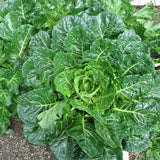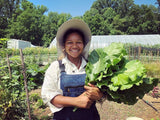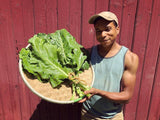Green Glaze Collards
Brassica oleracea
Green Glaze Collards are a beautiful, glossy, dark green, and historic variety known for its taste and some resistance to cabbage worms and cabbage loopers. Food historian Michael Twitty says this variety "is my personal favorite. They are pretty, waxy, crisp, tough against bugs and extremely delicious. They also happen to be the oldest variety we have/know of collard green dating back to the late 18th and early 19th centuries, with the Georgia Southern or Creole collard out of the Deep South going back to the 1860s-1880s." See Twitty's Afroculinaria blog for a description of how this European crop combined with African tastes and became so closely associated with southern Black foodways. A sneak peek: "In tropical West Africa, greens were available year round in gardens and markets and figured prominently in regular meals."
William Woys Weaver describes the origin of this particular variety: "One of the oldest [collards] to survive ... is the Green Glaze collard, a colewort that evolved out of the Green Glaze cabbage introduced in 1820 by David Landreth of Philadelphia."
Our seeds this year were grown by Amirah Mitchell of Sistah Seeds as part of her Seed Keeping Fellowship at Greensgrow Farms in Philadelphia. This is her favorite type of collard greens as well, and collards are one of her most dear ancestral foods.
Days to maturity: 79
Seeds per pack: 160-170
Germination rate: 88% on 11/08/2021
Planting / harvesting notes
Either start indoors or direct sow. Sow seeds 1/4" deep in potting soil 4-8 weeks before the last frost, and transplant when plants have three true leaves spaced at 1-2' apart, as early as just before the last frost. If we are growing them in the Fall, we either transplant as mentioned above or we directly sow our seeds 1/4" deep every few inches, and cover with hoops and plastic row covers. Regularly harvest these delicious leaves when young and tender!
Seed keeping notes
Isolate by 1/2 mile from other flowering members of B. oleracea, including Collards, Kale, Broccoli, Cauliflower, and Brussels Sprouts to avoid unwanted cross-pollination. Allow seed pods to turn brown and dry before seed harvest. Protect from birds.











